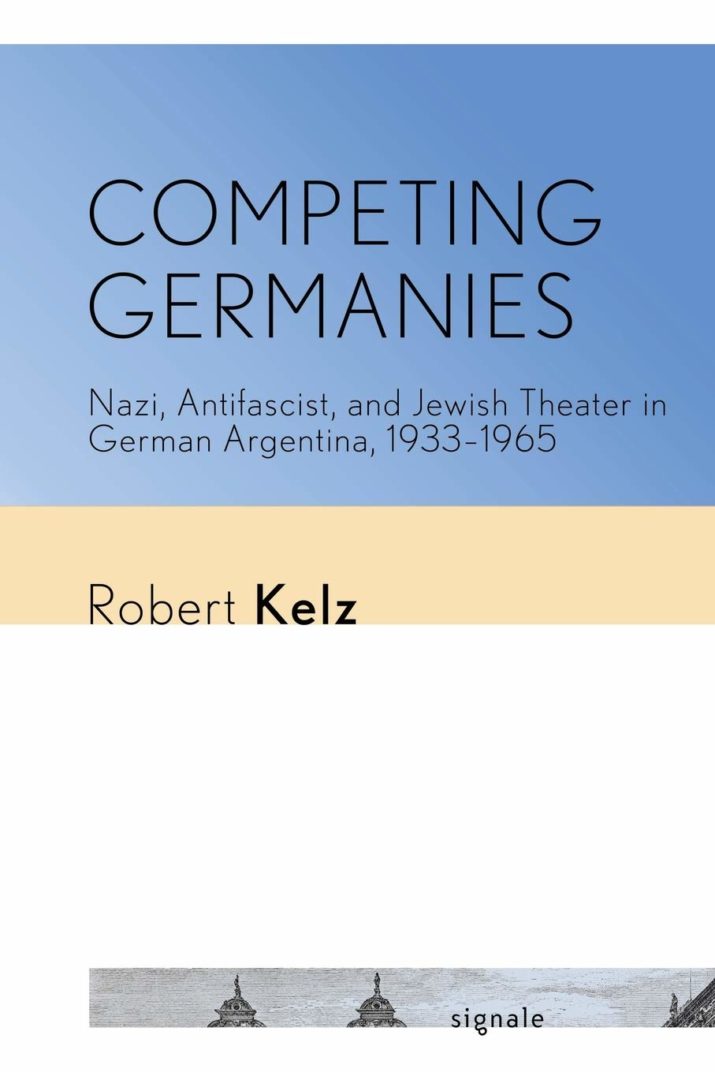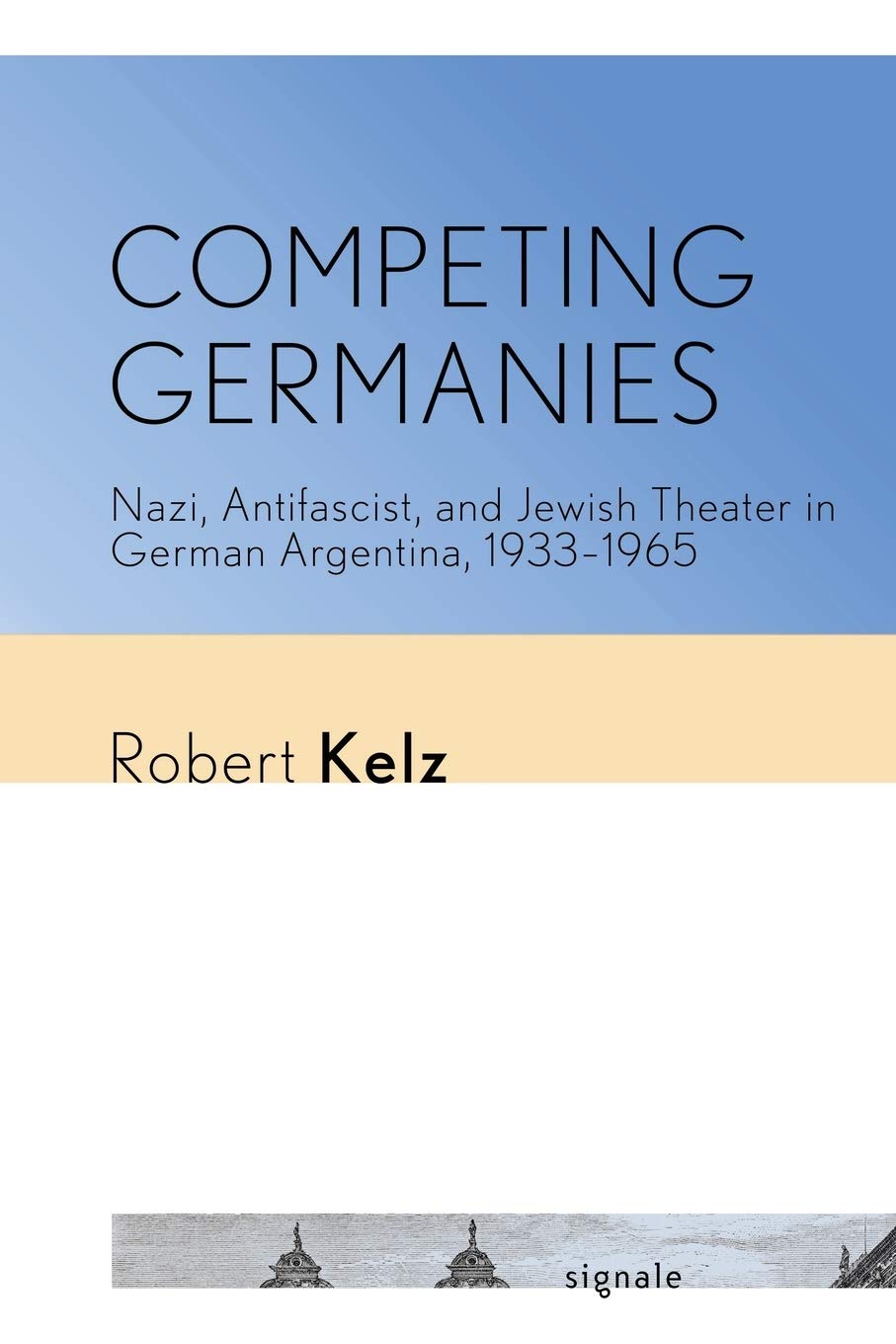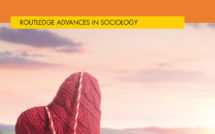
Competing Germanies: Nazi, Antifascist, and Jewish Theater in German Argentina, 1933–1965 by Robert Kelz

In the nineteenth century, Argentina was the country with the second-largest number of immigrants, behind only the United States. Many of them were Jews fleeing persecution in the Russian Empire. Around that time, the Zionist political leader, Theodor Herzl, was even considering plans for settlements in Argentina as an alternative to the colonization of Palestine. Although the idea of an Israel in Argentina floundered, these migratory trends continued into the twentieth century. Between 1933 and 1945, Argentina received more Jewish refugees proportionally to its population than any other place aside from Palestine. These later refugees, however, quickly found themselves in the very company they had tried to escape. With the German depression of 1920, German economic migration to Argentina had begun to increase and by the early 1930s, this population had formed a diaspora of its own with strong nationalist sentiments. This diaspora established such a presence that, supported with heavy diplomatic pressure from Nazi Germany, it successfully pressured the fascist-sympathetic Argentinian government to end its open policy to Jewish immigration in 1939 while maintaining an open policy to non-Jewish German migration. Through such policies, Argentina would notoriously accept over 5,000 German war criminals―among them Adolf Eichmann―some of whom fled after the country opportunistically declared war on Nazi Germany on March 27, 1945.
As Robert Kelz discusses in Competing Germanies: A Study of Two German Exile Theaters in Buenos Aires, the crisis of German-Jewish refugees not only carried European conflicts to Argentina, but also laid the foundation for one of the most important German-speaking exile theaters during the Second World War, the Free German Stage (FGS). Established in Buenos Aires by German-Jewish refugees in 1940, the FGS engaged in direct competition with the National Socialist (NS)-aligned German Theater (GT), which was founded just two years earlier in 1938. As Kelz makes clear in the book’s five chapters—two dedicated alternately to each theater’s history, one to each theater’s personnel, and one the continuing tensions between theater communities after both groups were dissolved—the troupes’ ideological divide ensured that the groups engaged in competition that was both a political battle over the repertoire, aesthetics, and ideological messaging of classic German theater, and a struggle for artistic freedom and existential survival. The end of the war not only brought an end to these conflicts in exile, but also inaugurated a new, synthetic phase for the German theater in Argentina, wherein the two troupes were merged and antagonisms (and, indeed, any overt references to the Holocaust) awkwardly suppressed under a shared anti-communist conviction.
The FGS has been studied for a long time and might be the most important exile theater researchers have discussed. Drawing from theater studies, performance analysis, and humor research, Kelz contributes to this historiography by analyzing the entire history of the FGS as a continued struggle to find a common ground among the different German audiences, a pursuit that met only limited success through the group’s dissolution in 1952. Lacking outside sources of support, the FGS was utterly dependent on its audience for survival and emphasized inclusion across the spectrum of the German-speaking exiles. This situation contrasted starkly with that of the GT, which was funded by National Socialist organizations and, in turn, functioned as a stage for nationalist propaganda in part by excluding German Jews and others considered not German. Both theaters staged comedies, often interspersed with satirical innuendo and political references. The FGS, however, relied on these productions for income, which allowed it to occasionally stage serious classical and political drama its professional actors and founder, Paul Walter Jacob, thrived on. The GT and its semi-professional and amateur actors, meanwhile, staged comedies to reach the widest possible audience for its crass propaganda. Kelz does well detailing the lengths to which the German Theatre’s dramaturgy went to distort classic German dramas into expressions of National Socialist-ideology.
Though artistically more refined, according to Kelz, the FGS encountered difficulties competing with the GT. This was not only because of financing and the large pool of German migrants who widely sympathized with the characteristic National Socialist appropriation of German folk-culture. These difficulties were compounded by the Argentinian government’s covert cooperation with the Nazi government, which colluded to target the FGS with a campaign of intimidation. At times, the family of FGS actors, who had remained in Europe, were persecuted. In some cases, they were apparently murdered by Nazi agents, though Kelz is careful not to suspend critical historiography for the lure of a thrilling, if conjectural, narrative. What is certain is that the German government went to great lengths to pressure the Argentinian government to shut down anti-fascist theater troupes. The FGS was ultimately forced to stop staging political drama altogether. However, owing to Jacob’s experienced management, it succeeded in stabilizing at least the economical existence of several German-Jewish refugees.
Kelz sympathetically describes Jacob’s balancing act of survival and shows how the FGS was caught between different rocks and hard places. In addition to the competition with the GT while under threat by local authorities, the FGS was also reproached by anti-fascist groups for not being more outspoken against the local German and Argentinian variants of fascism. From the other side, the FGS had to vie with a Zionist bloc, which sought to include its own works in the FGS repertoire despite the tendency of such propaganda to “consistently repulse audiences” not already sympathetic with the Zionist cause (160). Moreover, playing to Zionist audiences did not pay out. This was both because of the divisive effect of what Brigitte Dalinger has elsewhere identified as the Zionist dramatic genre of “tragedies of assimilation,”[1]which often denounced cultural and religious hybridity, as well as because “promoting Jewish content always resulted in lackluster ticket sales” (161). Kelz’s research, therefore, makes an important contribution to the discourse on Zionist drama and theater, in part because it depicts a phenomenon that stands in contrast to the Jewish reception of Zionist drama in Europe at the time. In its comparison with the European scene, Kelz’s book highlights how Jewish artists who had been seminal in modernizing German theater, continued to defend its classicist stance and humanist tradition against nationalist appropriation in Argentina. There, the Jewish struggle of survival played itself out on the theater stage and surprisingly reflected a performative microcosm of the German-Jewish social drama. Probably due to Kelz’s focus on the conflict between two German exile theaters, however, his study remains oblivious to transcontinental connections to the theatrical culture and struggles of their origin. For example, the Jüdischer Kulturbund (the Cultural Federation of Jews in Germany) is not mentioned once, nor is hardly any research on German-Jewish exile theater at the time beyond Argentina. For these ongoing discourses, Kelz’s book nevertheless provides an important reference point and comparative supplement, and its wide interdisciplinary scope will prove valuable to scholars from a wide variety of disciplines: German studies, Latin-American studies, Jewish studies, theater and migration studies.
In one of the most intriguing chapters of the book, which could well serve as the basis for a good movie script, Kelz describes in vivid detail Jacob’s flight from Vienna through Nazi-Germany to Argentina, a journey which only an actor like him could have managed. Jacob had to flee because of an ideology that preferred the national and ethnic origins of an actor over the quality of his acting skills, i.e. over his ability to impersonate and reflect different identities and, thus, to strengthen the diversity vital for democratic societies. The ability to freely choose different identities, nevertheless, stands at the core of artistic expression and was indeed antithetical to such political appropriation of thespian arts, as illustrated by the GT project. That is to say, although Competing Germanies is a highly specialized study, it has broad implications and should elicit wide interest, especially given current global migrant and refugee crises. What this book illustrates so clearly is that anyone can become a refugee at any time and that all the world is but a stage wherein men and women are merely players with exit and entrance visas.
Jan Kühne is an affiliated researcher at the Franz Rosenzweig Minerva Research Center for German-Jewish Literature and Cultural History at the Hebrew University of Jerusalem. He is currently working on projects examining German and Hebrew multilingualism in theater and literature, as well as on poetry and performativity, with special focus on bilingual homophony. His recent publications include “The Zionist Comedy in the Drama of Sammy Gronemann” (2020) and he is the editor-in-chief of the ongoing Critical Edition of Collected Works by Sammy Gronemann.
Competing Germanies: Nazi, Antifascist, and Jewish Theater in German Argentina, 1933–1965
By Robert Kelz
Publisher: Cornell University Press
Hardcover, Paperback and Ebook / 372 pages / 2020
ISBN: 9781501739866
References:
[1] Dalinger, Brigitte. “Trauerspiele mit Gesang und Tanz”: Zur Ästhetik und Dramaturgie jüdischer Theatertexte. Wien: Böhlau, 2010, pp. 176-197.




